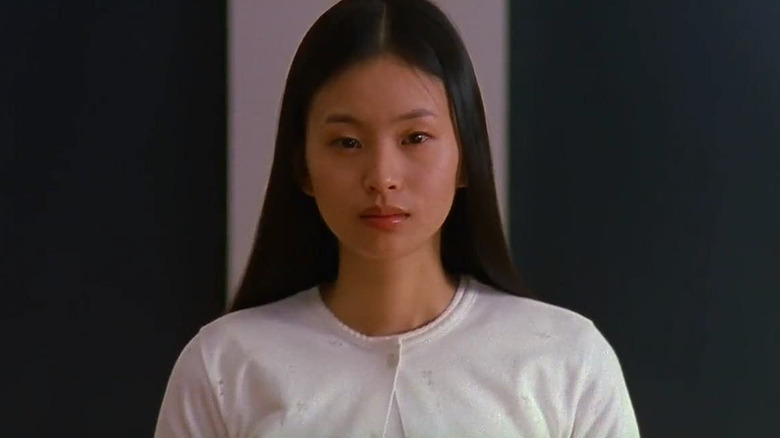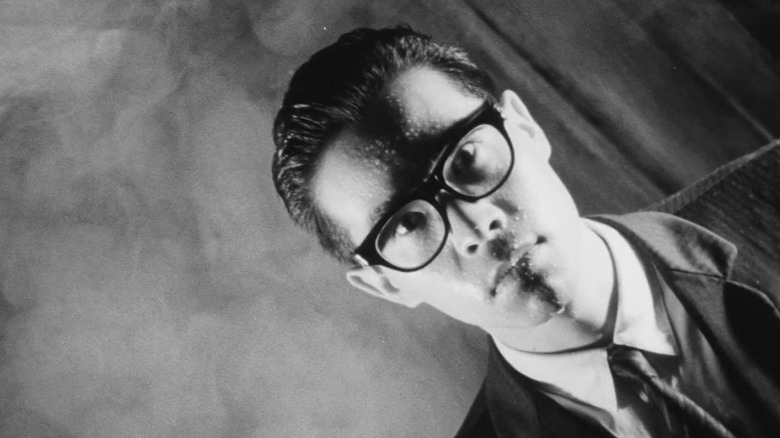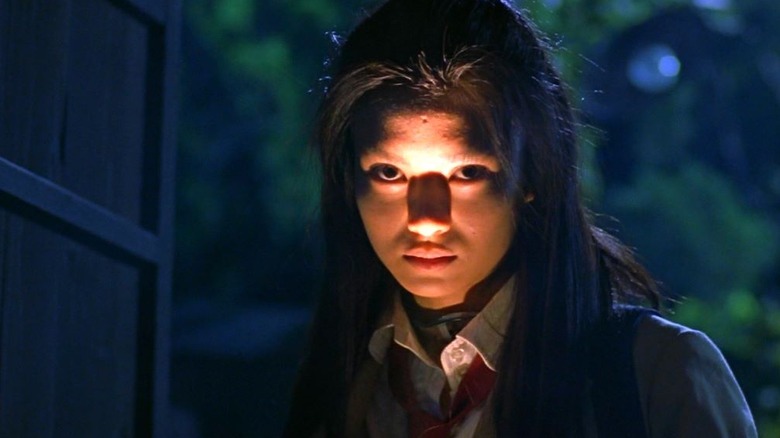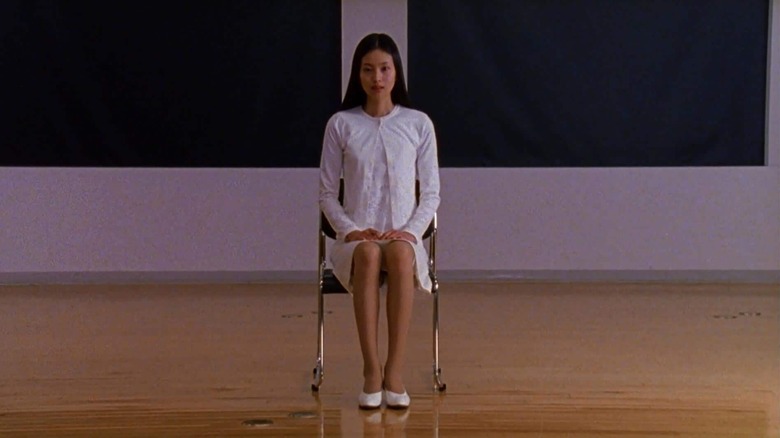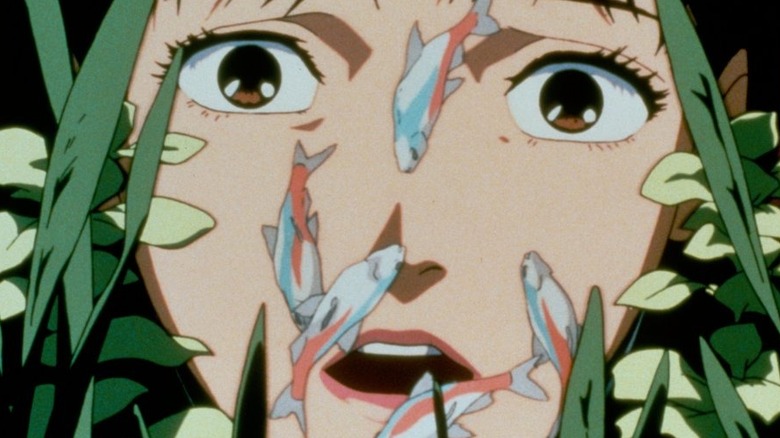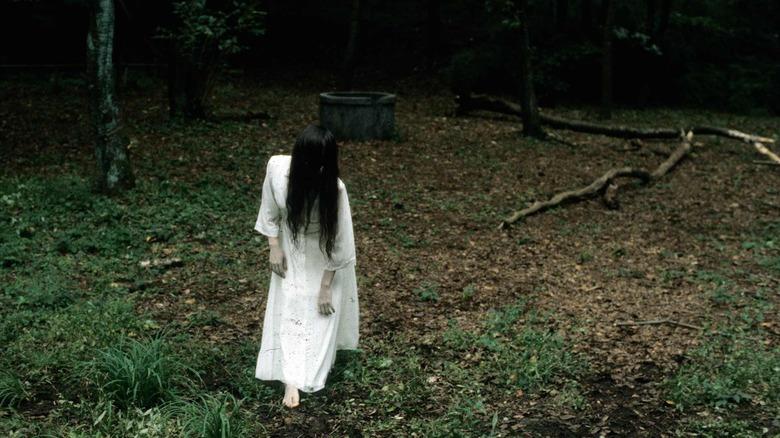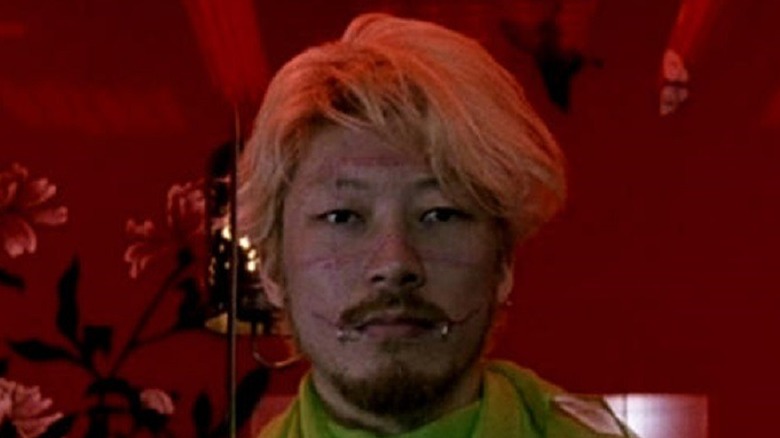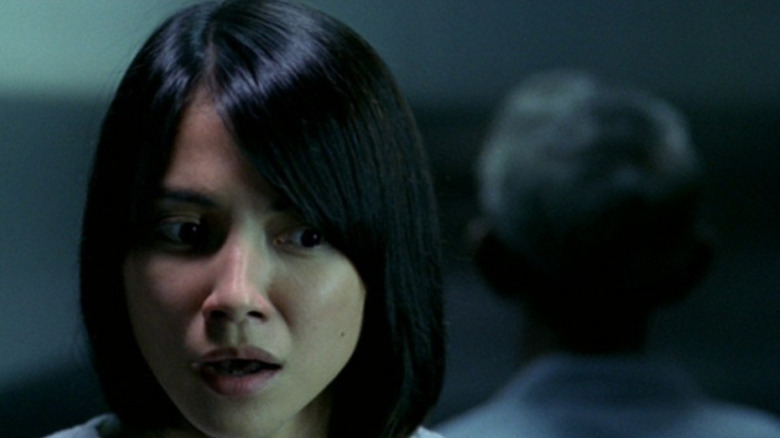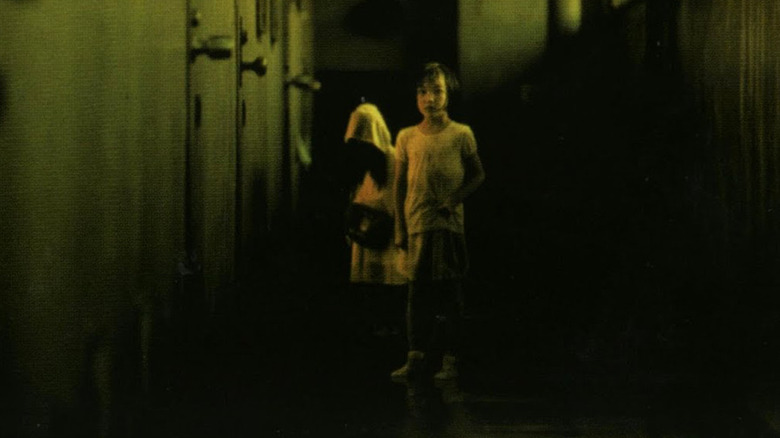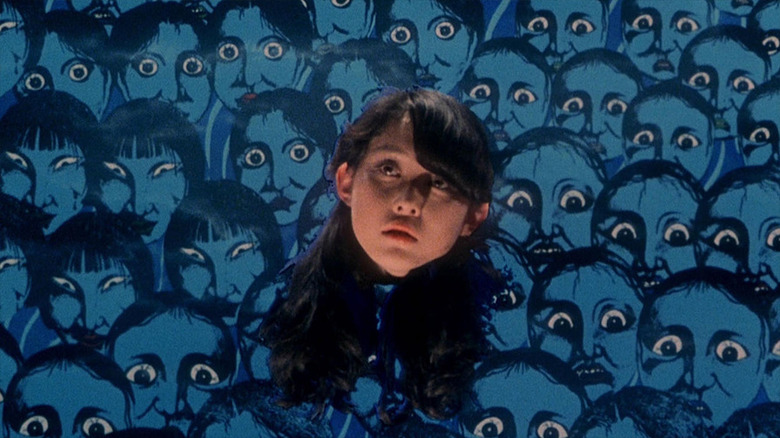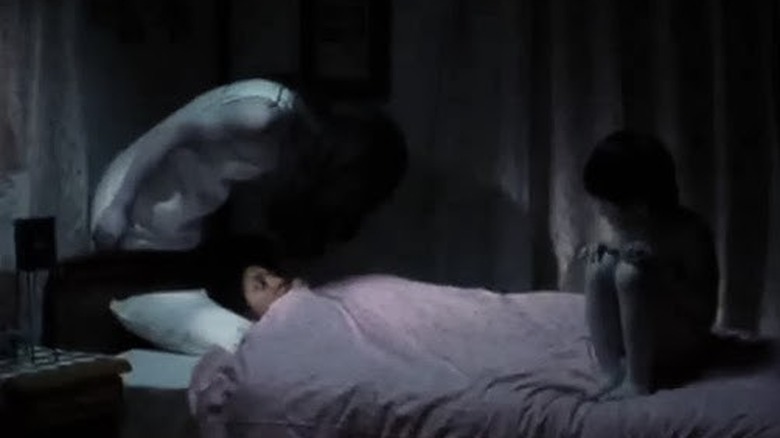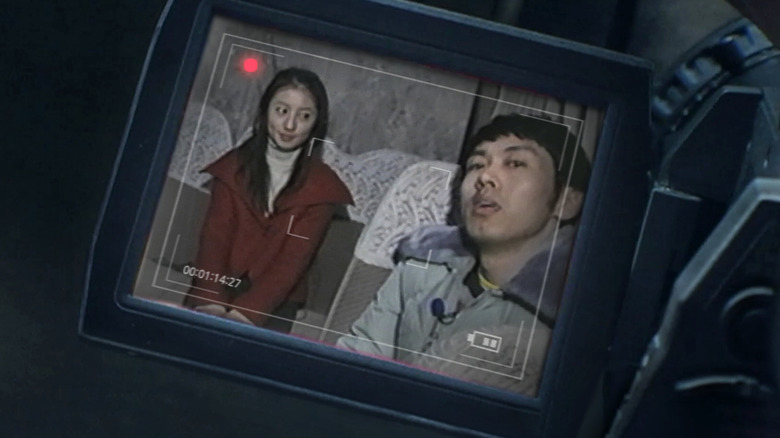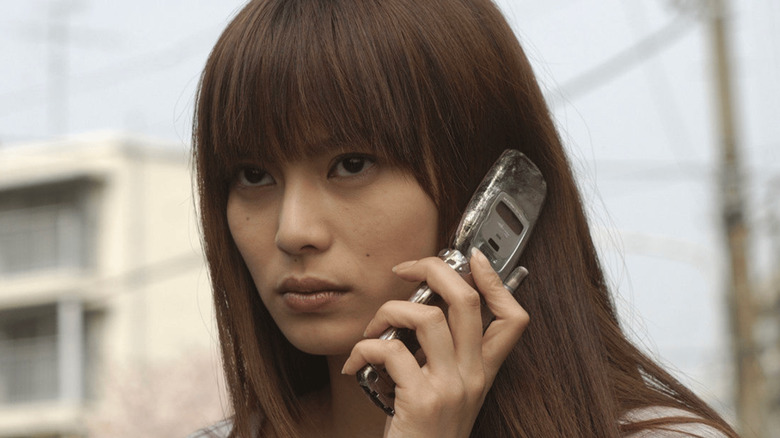Scariest Japanese Horror Movies Of All Time
Great art is not exclusive to any one region or country—especially not horror stories, which are ubiquitous across many cultures. Whether it's a Hollywood feature or an A24 indie production, the United States has a lock on some of horror's most recognizable icons and franchises, but that doesn't mean it's the only country in the world crafting cinematic nightmares.
Japan in particular has crafted some of the genre's most shocking entries. While this can be attributed to many causes, a culture steeped in folklore and ghost stories certainly helps. Several notable American horror flicks are actually adaptations of Japanese originals, including "The Ring" and "The Grudge."
J-horror is usually characterized by a steady build-up, protracted suspense, and unrelenting dread. Very often the films are visceral gorefests that will leave even the most seasoned horror fanatic shaken. Let's take a look at some of the scariest movies to emerge from the Land of the Rising Sun.
Tetsuo: The Iron Man
The best art often comes from the least expected places, which is most definitely the case for Shinya Tsukamoto's cyberpunk horror classic. Very few films defy conventional description like "Tetsuo: The Iron Man" does; that's partly why it's attained a cult following. The plot concerns a salaryman who one day begins a horrific bodily transformation into a twisted half-man/half-metal abomination. The film blends disturbing body horror with trippy, almost otherworldly visuals in an intentional car wreck of metallic insanity.
Tsukamoto made the movie for almost no money, using his own accrued part-time income to fund the underground project. The production was long, difficult, and tiresome, which resulted in most of the crew, aside from the actors, departing it. Despite the nightmarish production, Tsukamoto was able to complete this film, only to encounter distribution issues. When it finally debuted, it received an award for Best Film at the 1989 Fantafestival in Rome and went on to enjoy a limited but successful Japanese theatrical release. An eventual home media release followed, cementing the film as a bonafide cult hit.
"Tetsuo: The Iron Man" truly shows how great and subversive art can be made even on a shoestring budget.
Battle Royale
For a film to be truly scary, the viewer must be able to imagine themselves in its scenario. In "Battle Royale," the fear comes from wondering if you could survive your friend and classmates trying to kill you.
Based on the controversial novel, "Battle Royale" is the story of the Japanese government's radical plan to quell the nation's juvenile delinquency issues. The plan in question involves gassing an entire class of 42 students and sending them to a remote island. With exploding collars latched around their necks and a ticking clock, the game is on to be the sole survivor. What ensues is almost two hours of adolescent violence, rampant brutality, and escalating insanity as each student is slowly picked off.
Directed by Kinji Fukasaku and released in 2000, the film was an immediate box-office hit and magnet for controversy (the latter due in part to the film's shocking subject matter and its release in proximity to horrific real-life events). Despite this, the film has gone on to attain cult status, held in high regard by the likes of Quentin Tarantino.
In fact, Tarantino hailed the film as the best he'd seen in the previous 20 years and as his favorite film.
Audition
When you ask many horror fans what the scariest film ever made is, there's a good chance it'll be "Audition." The film sits prominently on various critical and fan compiled rankings, and there is a good reason for it. "Audition" is auteur Takashi Miike's masterpiece, not only for its nerve-wracking build-up, but also for its exemplary performances and disturbing imagery.
Shigeharu Aoyama, a recent widower, is convinced by his producer friend to use a faux audition to find the perfect woman. After much trial and error, Shigeharu is eventually smitten with the soulful Asami Yamazaki. But it becomes clear that Asami is harboring some dark and disturbing secrets that Shigeharu begins to uncover. As Asami's dark past starts to affect the present, Shigeharu realizes his life might be in danger. This culminates in one of horror cinema's most sickening, stomach-churning sequences as Asami graphically tortures him.
The standout performance belongs to Eihi Shiina as Asami Yamazaki, the love interest turned psychotic captor of the film. She strikes a perfect balance of earnest charm and rampant sadism, the latter of which is on full display in the film's climax.
Perfect Blue
The human mind can sometimes be the scariest thing imaginable, and that is on full display in "Perfect Blue."
The film, based on the book of the same name, is directed by the legendary Satoshi Kon. Provided he kept certain elements of the book intact, Kon was given carte blanche to do whatever he wanted. The film centers on Mima Kirigoe who, after making the transition from pop idol to actor, begins to question everything. Not only is she being followed by an obsessive stalker, but her perception of reality is beginning to deteriorate. Much of Kon's filmography deals with the constantly blurring lines of fantasy and reality, with "Perfect Blue" being no exception. Through its expertly timed animation and haunting score, the film has you second-guessing yourself as much as Mima is. Many have identified various themes such as one's own identity and the perceptions that come with fame.
The film is a noted influence on director Darren Aronofsky, who has gone on record about film frequently. He bought the rights to the film to use the bathtub scene in his own film "Requiem for a Dream." He has even acknowledged the similarities between "Perfect Blue" and his own film "Black Swan."
Ringu
If you want to talk about a spark setting off an entire powder keg, look no further than Hideo Hikata's "Ringu."
Reiko Asakawa, a Japanese news reporter, dives into an investigation regarding a mysterious and potentially deadly VHS tape. Viewing the tape results in the viewer getting a phone call that informs them they will die in seven days. This investigation leads to her uncovering the story of Sadako Yamamura, a vengeful psychic whose soul now inhabits the tape. "Ringu" got an increase in attention after the release of its American counterpart ("The Ring"). The film isn't just a great remake; it's also one of the best modern horror films. Its tremendous success opened the flood gates for Asian horror films to receive Western remakes.
The trend resulted in mostly poorly received films, but "The Ring" is still highly regarded close to two decades later. It's a rare feat within cinema when both a foreign film and its remake receive equal praise.
Ichi the Killer
While "Audition" might be Takashi Miike's most critically beloved film, "Ichi the Killer" might be even more sadistic.
"Ichi the Killer" is adapted from a horror manga by manga writer and artist Hideo Yamamoto. The film follows the titular Ichi, a mentally warped and sexually repressed man who derives pleasure from violent actions. This violent streak gets him caught up in a deadly yakuza rivalry and pursued by a masochistic enforcer. The film has been described as one of the most violent films of all time, and it definitely deserves that distinction. From countless acts of bodily dismemberment to sadistic torture and heinous sexual deviance, "Ichi the Killer" will make anyone squirm.
"Ichi the Killer" made its debut at the 2001 Toronto International Film Festival as a part of their Midnight Madness selection. The creators of the film provided those in attendance Ichi-branded puke bags. The film sought widespread distribution in other countries, but this proved to be impossible. Due to the film's unrelentingly shocking content, it was heavily cut down in locations like Hong Kong, and outright banned in Norway and Malaysia. Despite this increased notoriety, some critics did uncover the film's narrative intentions underneath its perverse and viscerally sickening exterior.
The Eye
"The Eye," directed by the directorial duo known as the Pang Brothers, is actually based on haunting true events. In interviews, the brothers stated that they'd read about a girl who, only one week after having her vision restored, tragically took her own life. The film of course takes massive liberties with this, only focusing on the eye transplant element and dramatizing the rest.
The film goes in a supernatural direction as protagonist Wong Kar Mun begins seeing shadowy figures after her cornea transplant. After teaming up with a psychotherapist, Dr. Wan, the duo looks to see what happened to Wong's donor Ling. They eventually learn of the paranormal events that caused her demise, which is now causing Wong to see ghosts. The film contains several creepy and suspenseful scenes, including a particularly nerve-wracking ghost encounter in an elevator. The film opened to respectable box office and reviews, which garnered the film two sequels and a remake.
Following the success of "The Ring" remake, studios were looking to retool more Asian horror films for the west. Many are probably familiar with the Western remake of "The Eye" starring Jessica Alba, a notoriously subpar interpretation.
Dark Water
After gaining positive attention with the "Ringu" films, Hideo Hikata once again delivered a haunting cinematic release.
"Dark Water," based on a short story, follows a mother, Yoshimi, and her young daughter, Ikuko. While contending with an unpleasant divorce mediation, Yoshimi moves herself and Ikuko into a dingy apartment complex. The issues start off small—a persistent leak in their roof from another apartment, say—but slowly escalate. Not only is the divorce taking a significant toll on Yoshimi, but the problems with the apartment also steadily become supernatural. Items begin appearing randomly in their unit, and they begin to notice a mysterious longhaired girl in a raincoat. The film, much like the apartment complex, is dripping in atmosphere, which only adds to its effect on the viewer.
Upon release in 2002, the film received many positive reviews and brought in impressive box office results. Its success spawned a Western remake starring Jennifer Connelly, which was released three years later to mixed reviews.
House
It's not uncommon for films to disappoint critics during their original release, only to become a cult hit with fans. When Nobuhiko Obayashi's "House" was released in Japan back in 1977, it got an extremely negative reception, but it has since gotten a critical reappraisal, with many viewers noting its unique visual effects and animated sequences. Some even count "House" as an all-time horror classic. It has received a glorious remastered release via the Criterion Collection and has been listed on several prominent cinematic rankings.
The plot concerns a girl named Gorgeous (yes, that's her actual name) and her classmates traveling to her aunt's country home. But what begins as a charming jaunt in the countryside quickly turns into a barrage of insanely bizarre occurrences. From a girl getting eaten by a piano to another getting trapped in a grandfather clock, the film never lets up in the slightest. The film takes the all-too-common trope of the haunted house and takes it to its most insane yet logical conclusion.
Ju-On: The Grudge
"Ju-On: The Grudge" is an oft-discussed entry in the Japanese horror canon.
The film focuses on a family that, just after moving into a new house, discovers it is rife with vengeful spirits. These include Kayako Saeki, a contorting pale white ghost with jet-black hair, and Toshio, a ghostly child with pitch-black eyes. It's revealed that both died in the house and are forever cursed to wreak bloody vengeance on anyone who enters. The film is packed with not only two of horror's most haunting specters, but also expertly crafted atmosphere. From Toshio appearing on the stairs to the masterfully directed shower scene, the film is loaded with haunting moments.
"Ju-On: The Grudge” gained increased exposure when it was remade in the United States as "The Grudge." Both the original and remake were directed by Takashi Shimizu—a rare occurrence in film production. The remake went on to become a box office smash, bringing in $187 million against a $10 million budget. This resulted in attention for the original, as well as various sequels and even a midquel.
Noroi: The Curse
Found footage has always been a sub-genre within horror fueled by creativity and innovation. The format allows scares to be presented in a grounded, yet visually interesting way that still keeps the budget small.
"Noroi: The Curse" uses all of its $2 million budget to tell a very inventive and engaging story. We are shown the story of Masafumi Kobayashi, a paranormal investigator and documentarian, who is alleged to be missing. We are then shown footage for his next documentary, called "The Curse," and what exactly led to his disappearance. The film uses the pseudo-documentary format to great effect, expertly telling the story while still maintaining the creepy atmosphere. One additional aspect that aids the film in its faux-reality is how several of the actors play themselves in-universe.
The film didn't make its way to other countries until years after its original Japanese release. Due to its underground status, the film developed a rabid cult following online despite not having a physical release. The film finally found a home on Shudder, introducing it to a swarm of new fans.
One Missed Call
Is it really our fault that Takashi Miike is the man behind several of Japan's most noteworthy horror contributions?
This film focuses on Yumi Nakamura, a student whose friend gets a disturbing voice message on her cell phone. Her friend, Yoko, hears what seems to be a future recording of herself in the midst of her own demise. This message is proven to have been a premonition when Yoko dies a few days later. This leads Yumi down a rabbit hole of horror and conspiracy to uncover the truth behind these paranormal phone calls. The film takes several interesting twists and turns, all guided by Miike's masterful eye for detail and atmosphere. Creepy phone calls are a long-running horror film trope that "One Missed Call" takes and runs with in a truly unique way.
Many might be more familiar with its Western remake of the same name, but for all the wrong reasons. It's a film whose greatest claims to fame are having a 0% on Rotten Tomatoes and being the worst-reviewed film of 2008. For a better time, stick to Miike's original.
